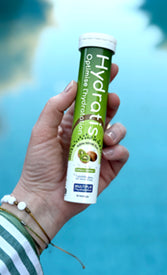Excess sugar is harmful to health. ANSES (the French Agency for Food, Environmental and Occupational Health & Safety) recommends not exceeding 100 grams per day. To enjoy the sweet taste without the drawbacks of sucrose , sorbitol presents itself as an interesting alternative. Half the calories and non-cariogenic , it is already present in many everyday products. But behind these advantages, side effects sometimes lurk , especially in cases of excessive consumption. In this article, we review its uses, benefits, risks, and recommendations for using sorbitol safely.
What is sorbitol (E420)?
Origin: natural or synthetic?
Also called glucitol , orbitol is part of the polyols , a family of bulk sweeteners incorporated into various food, cosmetic and pharmaceutical products.
First discovered in rowan berries , hence its name, it occurs naturally in fruits such as apples, pears, plums, and cherries. However, the quantities found naturally are limited. To meet industrial needs , it is now synthesized on a large scale from glucose. This is why it is a sugar alcohol.
Like other regulated chemicals such as sodium citrate or potassium nitrate, sorbitol is classified by the Codex Alimentarius as a food additive under code E420 .
Presence in everyday foods and products

You may already be consuming sorbitol without realizing it.
Indeed, it is present in many "reduced calorie" foods , "products" without added sugars or diet products: chewing gums, candies, confectionery, jams and syrups.
Besides food, this sweetening molecule is also found in other products used every day. Just pay closer attention to labels and you'll almost certainly see it in your toothpaste, mouthwash, moisturizers ... as well as in some medications.
How is it manufactured industrially?
Glucose or fructose derived from starch (often corn or potato) is reduced to sorbitol by Catalytic hydrogenation . This process produces a liquid solution or a sweetener powder that is weakly soluble in ethanol but very soluble in water.
What is the purpose of sorbitol?
In the food industry
Used as a sweetener , E420 replaces sucrose in some " no added sugar " products with half the calories . It also helps improve the texture and extend the shelf life of biscuits and canned fruit thanks to its humectant properties.
In medicines and food supplements
In the pharmaceutical sector, sorbitol is mainly used as a humectant excipient Stabilizer . It adds volume, a sweet taste and facilitates the dissolution of active ingredients.
It is also the active ingredient in certain laxative products , such as Sorbitol Delalande 5g . This medication is used to treat temporary constipation. It is administered orally and stimulates intestinal transit .
In cosmetics and hygiene products
Sorbitol is valued in cosmetics and hygiene products for its humectant properties . It captures and retains water, which helps to preserve the suppleness of preparations and prevent them from drying out.
It is also used as a texturizing and stabilizing agent, allowing for a smooth and pleasant consistency upon application. It is therefore found in toothpastes (where it also contributes to a mild taste), as well as in lotions, creams, and mouthwashes.
Sorbitol and health: benefits and drawbacks
Advantages: low glycemic index, non-cariogenic
Unlike sucrose , this polyol has a low glycemic index : it does not cause a sudden spike in blood sugar. It could therefore be suitable for you if you are diabetic , provided you do not consume too much of it .
Another positive point : sorbitol is considered to be Non-cariogenic . This means that it is not metabolized by oral bacteria responsible for acid production and therefore does not promote enamel demineralization .
Side effects: digestive problems, intolerances
Sorbitol is one of the FODMAPs are sugars and alcohols that are poorly absorbed by the body . During their metabolism, only a portion is absorbed in the small intestine. The rest travels to the colon, where it is fermented by intestinal bacteria.
That is why, in some people, even small doses can cause digestive discomfort.
Of the Clinical studies show that in healthy adults, 10g can already cause bloating and gas. Beyond 20g per day , symptoms can worsen , leading to abdominal pain or diarrhea.
Specific risks: children, sensitive individuals, intestinal disorders
Children , due to their low body weight, are particularly sensitive to the laxative effects of sorbitol . Therefore, it is not recommended in infant formula , except when specifically indicated .
If you suffer from If you have irritable bowel syndrome (IBS) or inflammatory bowel disease (IBD), this substance may worsen your symptoms. It's best to avoid taking it in these cases to prevent any risk, or consult your doctor.
Is sorbitol dangerous?
What do the health authorities (EFSA, ANSES) say?
Are you wondering if sorbitol poses a danger to your health?
According to the EFSA (European Food Safety Authority), this substance is considered safe when consumed in reasonable quantities . Problems generally arise mainly if you ingest an excessive dose.
In the European Union , products containing more than 10% added polyols , including sorbitol, must must bear the statement : "Excessive consumption may have laxative effects".
ANSES also recommends moderation, especially for children and people prone to digestive problems . It is therefore important to monitor your intake by carefully reading the labels of the products you consume.
There is no official daily intake for sorbitol, as it is classified as a food additive. ADI "unspecified " . However, as a polyol, it is prohibited in soft drinks.
Is it made from GMO raw materials?
Industrial sorbitol is produced from glucose, primarily derived from corn starch . Depending on the supply chain, this corn may come from genetically modified crops . However, the final molecule is purified, and no toxic effects are associated with its origin.
Is it safe in the long term?
To date, studies have not shown any chronic toxicity associated with moderate sorbitol consumption . Adverse effects are primarily gastrointestinal and related to excessive consumption. No research data suggests a carcinogenic or metabolic risk either .
Sorbitol for diabetics: good or bad idea?

Impact on blood sugar
If you are diabetic , sorbitol, consumed in small quantities, constitutes a An interesting substitute for regular sugar . Its low absorption and low glycemic index can help maintain your blood sugar levels after meals.
Risks and recommendations
Consumed in excess, it can cause digestive problems such as bloating or diarrhea . If you have diabetes, its use should be very occasional and only under medical supervision . Pay particular attention to the intake of processed foods to avoid excessive sorbitol consumption in a single day. We recommend avoiding it during prolonged physical activity.
Alternatives to sorbitol
Xylitol
Xylitol is another polyol with a taste similar to sugar and a non-cariogenic effect . You can use it as a substitute for sorbitol, but be aware that it can also have a laxative effect if consumed in excess.
Erythritol
Erythritol is better tolerated by the digestive system because it is largely absorbed before reaching the colon. It is a good alternative if you are sensitive to polyols.
Stevia and other natural sweeteners
Unlike aspartame and acesulfame K , which are artificial sweeteners, stevia is a natural sweetener with no calories and no noticeable effect on blood sugar . Well-tolerated, it is increasingly used. Monk fruit and inulin are also interesting natural alternatives.
Frequently Asked Questions
Is sorbitol natural?
Yes and no, it exists naturally in some fruits, but the sorbitol in industrial products is mostly made from glucose.
Is sorbitol dangerous?
No, as long as you take it in moderation, it's not dangerous. However, its laxative effect can cause digestive upset if consumed in excess.
Which foods contain the most sorbitol?
Naturally: apples, pears, plums, prunes. Industrially: confectionery, syrups, chewing gum, jams, "no added sugar" foods.
What types of people should avoid it?
Children, people with chronic digestive disorders (IBS, IBD), or those sensitive to food additives should limit or avoid intake.
Conclusion
Sorbitol is a natural sweetening polyol used as a sweetener, excipient, and food additive. It offers several advantages: a low glycemic index, non-cariogenic properties, and versatility . It is not harmful when used in moderation . In very small doses, it can relieve constipation. However, it can cause side effects at doses of 10-20 g/day and should be consumed with caution.
Monitor your intake, especially if you are diabetic or prone to digestive problems.
Read the labels to avoid accumulating too many products containing sorbitol.
Diversify your sources of sweeteners : erythritol, stevia, xylitol can be useful alternatives.
Bibliography
Livesey G. (2003) . Health potential of polyols as sugar replacers, with emphasis on low glycaemic properties. Nutrition research reviews , 16 (2), 163–191. https://doi.org/10.1079/NRR200371
World Health Organization & Food and Agriculture Organization. (nd). Sorbitol: Information from the Joint FAO/WHO Expert Committee on Food Additives (JECFA), INS 420(i) . JECFA database. Accessed on [September 13, 2025], from https://apps.who.int/food-additives-contaminants-jecfa-database/Chemical/3018
Van Gorp, K., & Van der Voort, P. (1999). Catalytic hydrogenation of fine chemicals: sorbitol production. Catalysis Today, 49 (1), 3-10. https://doi.org/10.1016/S0920-5861(99)00087-5
National Authority for the Safety of Medicines and Health Products (ANSM). (September 3, 2025). Sorbitol Delalande 5 g, powder for oral solution in sachet . Public database of medicines. Ministry of Health. Accessed [September 13, 2025], https://base-donnees-publique.medicaments.gouv.fr/medicament/67851645
Clinical Effects of Sugar Substitutes on Cariogenic Bacteria. (2024). Archives of Oral Biology . Advance online publication. https://doi.org/10.1016/j.archoralbio.2024.106238
Hyams JS (1983) . Sorbitol intolerance: an unappreciated cause of functional gastrointestinal complaints. Gastroenterology , 84 (1), 30–33. https://pubmed.ncbi.nlm.nih.gov/6847853/
Liauw, S., & Saibil, F. (2019). Sorbitol: Often forgotten cause of osmotic diarrhea. Canadian family physician Medecin de famille canadienne , 65 (8), 557–558. https://pmc.ncbi.nlm.nih.gov/articles/PMC6693595/
Lenhart, A., & Chey, W.D. (2017). A systematic review of the effects of polyols on gastrointestinal health and irritable bowel syndrome. Advances in Nutrition, 8(4), 587–596. https://doi.org/10.3945/an.117.015560
European Commission. (n.d.). Regulation on polyols, including sorbitol, and on the labelling of “laxative effects” (LEGISSUM: L21069) . EUR-Lex. https://eur-lex.europa.eu/legal-content/FR/TXT/HTML/?uri=LEGISSUM%3Al21069
Committee on Toxicity of Chemicals in Food, Consumer Products and the Environment. (2019). Toxicological evaluation of certain food additives in infants and young children: TOX/2019/36 . Food Standards Agency. https://cot.food.gov.uk/sites/default/files/tox2019-36.pdf
Livesey G. (2003). Health potential of polyols as sugar replacers, with emphasis on low glycaemic properties. Nutrition research reviews, 16(2), 163–191. https://doi.org/10.1079/NRR200371






